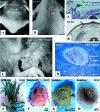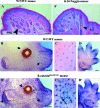A new scenario for the evolutionary origin of hair, feather, and avian scales
- PMID: 19422430
- PMCID: PMC2736124
- DOI: 10.1111/j.1469-7580.2008.01041.x
A new scenario for the evolutionary origin of hair, feather, and avian scales
Abstract
In zoology it is well known that birds are characterized by the presence of feathers, and mammals by hairs. Another common point of view is that avian scales are directly related to reptilian scales. As a skin embryologist, I have been fascinated by the problem of regionalization of skin appendages in amniotes throughout my scientific life. Here I have collected the arguments that result from classical experimental embryology, from the modern molecular biology era, and from the recent discovery of new fossils. These arguments shape my view that avian ectoderm is primarily programmed toward forming feathers, and mammalian ectoderm toward forming hairs. The other ectoderm derivatives - scales in birds, glands in mammals, or cornea in both classes - can become feathers or hairs through metaplastic process, and appear to have a negative regulatory mechanism over this basic program. How this program is altered remains, in most part, to be determined. However, it is clear that the regulation of the Wnt/beta-catenin pathway is a critical hub. The level of beta-catenin is crucial for feather and hair formation, as its down-regulation appears to be linked with the formation of avian scales in chick, and cutaneous glands in mice. Furthermore, its inhibition leads to the formation of nude skin and is required for that of corneal epithelium. Here I propose a new theory, to be further considered and tested when we have new information from genomic studies. With this theory, I suggest that the alpha-keratinized hairs from living synapsids may have evolved from the hypothetical glandular integument of the first amniotes, which may have presented similarities with common day terrestrial amphibians. Concerning feathers, they may have evolved independently of squamate scales, each originating from the hypothetical roughened beta-keratinized integument of the first sauropsids. The avian overlapping scales, which cover the feet in some bird species, may have developed later in evolution, being secondarily derived from feathers.
Figures







Comment in
-
'The integument story: origins, evolution and current knowledge'.J Anat. 2009 Apr;214(4):407-8. doi: 10.1111/j.1469-7580.2009.01051.x. J Anat. 2009. PMID: 19422422 Free PMC article. No abstract available.
References
-
- Alibardi L. Adaptation to the land: the skin of reptiles in comparison to that of amphibians and endothermic amniotes. J Exp Zool B Mol Dev Evol. 2003;298:12–41. - PubMed
-
- Alibardi L, Thompson MD. Scale morphogenesis and ultrastructure of demis during embryonic development in the alligator (Alligatormississipiensis, Crocodilia, Reptilia) Acta Zoologica. 2001;81:325–338.
-
- Alibardi L, Sawyer RH. Immunocytochemical analysis of beta keratins in the epidermis of chelonians, lepidosaurians and archosaurians. J Exp Zool. 2002;293:27–38. - PubMed
-
- Andl T, Reddy ST, Gaddapara T, Millar SE. WNT signals are required for the initiation of hair follicle development. Dev Cell. 2002;2:643–653. - PubMed
-
- Antoniazzi MM, Jared C, Junqueira LCU. Epidermal glands in squamate: fine structure of pre-cloacal glands in Amphisbaena alba (Amphisbaenia, Amphis baenidae) J Morphol. 2005;221:101–109. - PubMed
Publication types
MeSH terms
Substances
LinkOut - more resources
Full Text Sources
Other Literature Sources
Research Materials

